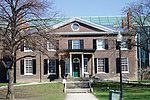The Michener Institute
The Michener Institute of Education at UHN, or simply Michener, is a specialist post-secondary institution in Toronto, Ontario, Canada. Based in Downtown Toronto and governed by the University Health Network (UHN), Canada's largest funded health care organization, Michener was founded by Dr. Diana Michener Schatz as the Toronto Institute of Medical Technology in 1958 with a pilot program in Medical Laboratory Technology at the Toronto General Hospital. After years of expansion through more programs offered, the institute was relocated to its present campus in 1972 at 222 St. Patrick Street and was renamed "The Michener Institute" after Dr. Schatz's father, Roland Michener (former Governor General of Canada) in 1990. The institute is funded by the Ontario Ministry of Health. The Michener Institute consists of a School of Applied Health Sciences and a School of Continuing Education. Within its School of Applied Health Sciences, it offers certification in various medical technologies, including Chiropody, Cardiovascular Perfusion, Diagnostic Cytology, Medical Laboratory Science, Respiratory Therapy, Ultrasound, Radiation Therapy, and Genetics Technology. Michener Institute also offers a number of joint programs with the University of Toronto.
Excerpt from the Wikipedia article The Michener Institute (License: CC BY-SA 3.0, Authors).The Michener Institute
St. Patrick Street, Toronto
Geographical coordinates (GPS) Address Nearby Places Show on map
Geographical coordinates (GPS)
| Latitude | Longitude |
|---|---|
| N 43.655147222222 ° | E -79.390580555556 ° |
Address
St. Patrick Street 203
M5T 2W5 Toronto
Ontario, Canada
Open on Google Maps








